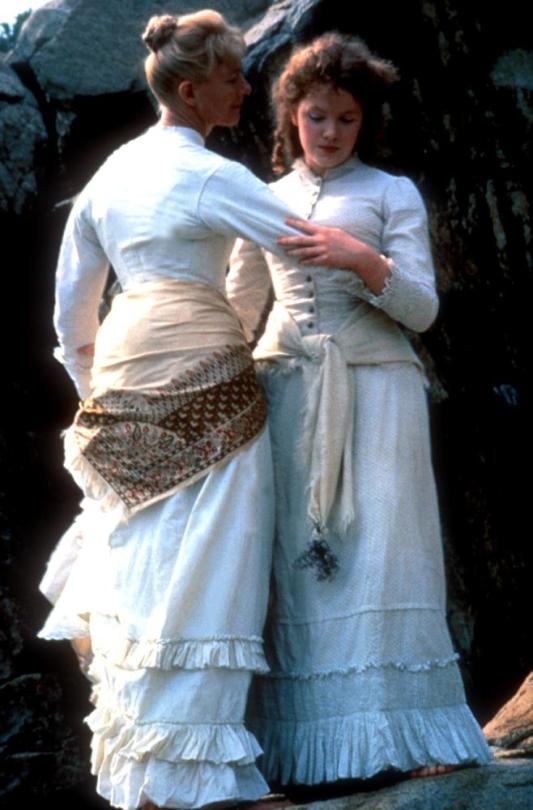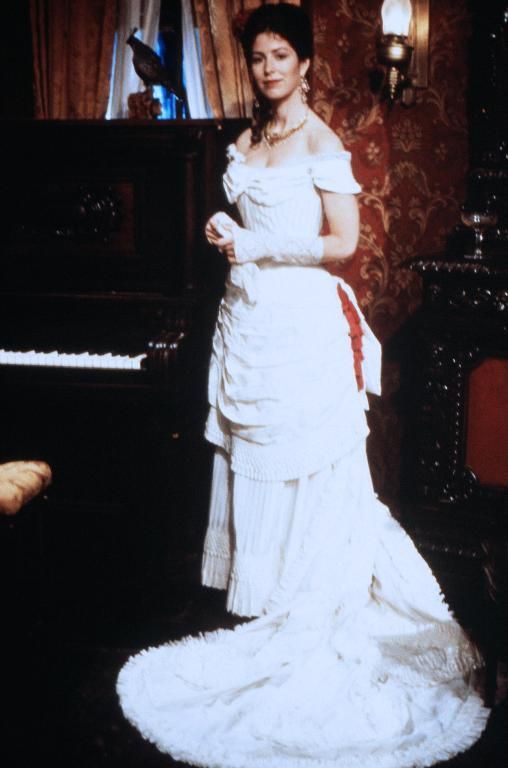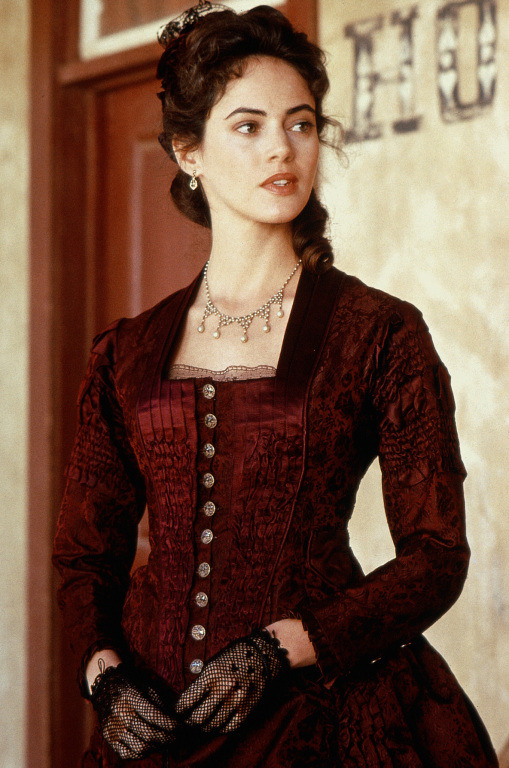
“WIVES AND DAUGHTERS” (1999) Review
Twenty-one years have passed since the BBC first aired “WIVES AND DAUGHTERS”, the 1999 adaptation of Elizabeth Gaskell’s 1865 novel. And despite the passage of time, it has a sterling reputation as one of the best adaptations of a literary source in recent years.
Adapted by Andrew Davies and directed by Nicholas Renton, “WIVES AND DAUGHTERS” told the story of Molly Gibson, the young daughter of a local village doctor during the last decade of the Georgian era. The four-part miniseries struck me as Molly’s coming-of-age story. She and her widowed father lived an idyllic life until two things occurred. One, her father married a woman she disliked, a former governess named Hyacinth “Claire” Kirkpatrick. And two, Molly fell in love with one Roger Hamley, the scientifically-minded younger son of a local squire.
If Dr. Gibson had his way, Molly would have never experienced any coming-of-age. But after one of his apprentices became romantically interested in her, he became determined to keep her in a state of perpetual adolescence. But his actions merely ensured that he would fail. First, he arranged for Molly to become the companion to Mrs. Hamley, the sickly wife of the squire. This gave Molly the opportunity to form an emotional attachment to the Hamley, befriend and fall in love with younger son, Roger. Then Dr. Gibson committed another act that defeated his purpose. He married former governess Hyacinth Kirkpatrick in order to provide Molly with a stepmother. This action backfired, since Molly never warmed up to the selfish and socially ambitious older woman. However, she did befriend the new Mrs. Gibson’s rebellious and more worldly and daughter, Cynthia Kirkpatrick. Not only did both Kirkpatrick women managed to disrupt the Gibson household, but Molly’s relationship with Cynthia would open her eyes to a great deal more about relationships and life in general – both the good and bad.
Other subplots abounded in ”WIVES AND DAUGHTERS”. Molly had a first-hand look into the conflict between the loveable, yet impatient and slightly selfish Squire Hamley and his more genteel older son, Osbourne. At first, the Hamleys seemed to regard Osbourne as the key to the family’s return to its former glory. But Osbourne’s scholastic troubles and excessive spending (for a secret French wife for whom he provided a private household) ended up disappointing Squire Hamley. Instead, he transferred his hopes to his younger and more studious son, Roger; who seemed to be on the verge of making a name for himself as a naturalist in Britain’s scientific community.
Another subplot centered on Cynthia Kirkpatrick. The French-educated and very beautiful young woman seemed to have struck both the Gibson family and the village of Hollingford with the force of a whirlwind. Cynthia projected a sexuality and worldliness that attracted nearly every male around her – including Roger Hamley. Unfortunately for Molly, Mrs. Gibson’s plans for her daughter included an ambitious marriage to the older Hamley sibling, Osbourne. But when the intensely pragmatic woman discovered that the older Hamley sibling’s health was in a precarious state, she encouraged Cynthia to set her sights on Roger. And considering his feelings for her, Cynthia had no trouble in achieving her mother’s goals with an engagement. Cynthia also had a secret that eventually affected Molly. Five years before, she had become secretly engaged to Lord Cumnor’s land agent, Mr. Preston. The latter’s insistence on a wedding date and Molly’s involvement on Cynthia’s behalf led the doctor’s daughter to become a target of village gossip.
Not only is Gaskell’s novel considered a masterpiece by literary critics, but this 1999 adaptation turned out to be highly regarded by television critics and viewers, as well. Some critics consider it to be the best adaptation of a Gaskell novel. Other critics believe it might be a toss-up between ”WIVES AND DAUGHTERS” and the 2007 miniseries, ”CRANFORD”. The 1999 miniseries certainly won its share of television awards. And if I must be honest, those awards were well-deserved. ”WIVES AND DAUGHTERS” provided a complex and in-depth peek into an English village society during the last decade of the Georgian era through the eyes of Molly Gibson. I must admit that I have rarely come across a movie or television series set during the 1820s or the 1830s. And I would certainly consider ”WIVES AND DAUGHTERS” among the best. Screenwriter Andrew Davies and director Nicholas Renton did a marvelous job in drawing the audience into Molly’s world.
The setting and story of ”WIVES AND DAUGHTERS” – or at least most of them – seemed to perfectly represent this precarious stage in Britain’s history in which the country found itself balanced between the static world of the Georgian period and the social and scientific upheavals that ushered in the Victorian Age. Davies and Renton manifested this in Molly’s coming-of-age story, which included her father’s reluctance to allow her to develop into an adult and her relationship with Cynthia. The screenwriter and the director also manifested this precarious stage in the relationship between Squire Hamley and his two sons – Obsbourne and Roger. As for the latter, many believe that Gaskell based his character on her distant cousin, the naturalist Charles Darwin who became a prominent figure in the Victorian Age’s scientific community.
Davies and Renton also did an excellent job of exploring the in-depth emotions of familial and romantic love in ”WIVES AND DAUGHTERS” also explored the in-depth emotions of familial and romantic love. Molly’s close relationship with her father – fully explored in Episode One – eventually grew weaker due to Dr.Gibson’s attempts to keep her close and at an adolescent stage. I found it interesting that although Squire Hamley grew to adore Molly, he made it clear to the doctor that he would never consider her – the daughter of a country doctor – as a suitable wife for either of his sons. Yet, Roger Osborne ended up married to a young French woman beneath his social station, and Roger eventually became engaged to Dr. Gibson’s step-daughter, Cynthia and married to Molly by the end of the series. Already, Victorian Britain’s social upheavals – at least in ”WIVES AND DAUGHTERS” – had began to rear its head. Cynthia’s love life, which turned out to be the best plotline in the story – also turned Molly’s life upside-down and forced her onto the path of adulthood.
The miniseries’ greatest virtue turned out to be the collection of complex supporting characters that gave ”WIVES AND DAUGHTERS” its energy and drive. For me, this was especially true of five characters – Hyacinth Kirkpatrick Gibson (Francesca Annis), Squire Hamley (Michael Gambon), Osborne Hamley (Tom Hollander), Mr. Preston (Iain Glen) and Cynthia Kirkpatrick (Keeley Hawes). When the miniseries focused upon these characters, I found myself fascinated by the story. Each character struck me as so complex that it seemed a pity that none of them was the main character. Michael Gambon won both a BAFTA TV Award and a Royal Television Society Award for his portrayal of the likeable, yet socially rigid and selfish landowner, who seemed determined to return his family to its former glory, via one or both of his sons. I must admit that Squire Hamley was truly a fascinating and complex character. Although I liked him a lot, there were times I could have happily strangle him for viewing his sons as instruments for his familial ambitions and inability to truly understand them at times. Francesca Annis earned a nomination for her portrayal of the self-absorbed and social climbing Hyacinth Kirkpatrick Gibson. One would, at first, be inclined to label Hyacinth as an “evil” stepmother. But Annis’ performance made it clear that Hyacinth was not at all one-dimensional. She also managed to inject a good deal of pathos into her character, allowing one to understand that some of Hyacinth’s behavior stemmed from a sense of survival for herself and her family, due to years spent in the social wasteland as a governess and underpaid schoolteacher.
Tom Hollander gave a very affecting and sympathetic performance as the poetic Osborne Hamley, the squire’s elder son who constantly disappointed his father. From other articles and reviews of ”WIVES AND DAUGHTERS”, many tend to view Osborne as a weak and self-involved man. I never got that impression from Hollander’s complex portrayal. Instead, I saw a man whose only real weakness was an inability to admit to his father that he had made a socially inacceptable marriage. It was this weakness that led to scholastic problems at the university and monetary problems. Iain Glen’s Mr. Preston seemed to be the villain of the story – at least on a superficial level. His Mr. Preston tried to coerce Cynthia into honoring her promise to marry him after five years. Superficially, Glen portrayed Mr. Preston as a smug and slightly arrogant man, who seemed obsessed with Cynthia. However, thanks to his complex performance, he revealed to audiences that Mr. Preston had been nothing more than a victim of Cynthia’s capricious and selfish behavior. As for Cynthia, Keely Hawes gave a delicious performance as Molly’s sexy and very likeable step-sister. What I found interesting about Hawes’ Cynthia is that the character possessed a talent for avoiding responsibility for her actions, along with an inability for returning love . . . yet, seems quite capable of winning the affections of everyone around her. Except for Dr. Gibson. The rest of the cast included Bill Paterson, who gave a charming, yet complex performance as Dr. Gibson; along with Barbara Flynn and Deborah Findlay as the Misses Brownings, and Rosamund Pike as Lady Harriet Cumnor, who all gave solid performances.
Justine Waddell did a good job in carrying the four-part miniseries and making Molly Gibson a very likeable leading character. Yet, there were times when Waddell’s Molly came across as a bit too ideal for my tastes. Aside from her quick temper, she seemed to lack any real personal flaws. One could name her naivety as a flaw. But that particular state of mind is something the average human being will always experience during his or her lifetime. Overall, Molly was . . . nice, but not what I would call an interesting lead character. Her reaction to her father’s new marriage and her involvement with Cynthia’s problems with Mr. Preston seemed to be the only times I truly found her interesting. I certainly could not say the same about Squire Hamley’s younger son, Roger. In fact, I did not find him interesting at all. To me, Roger was simply a BORING character. Perhaps Anthony Howell was not at fault and did all he could with the role. The actor certainly portrayed Roger as a likeable and compassionate man. But the character was just boring. If I had been Gaskell or even Davies, I would have portrayed Roger as a more complex and interesting character. Or allow Molly to fall in love with a more interesting character. Alas, neither happened. Roger’s only flaw seemed to be a habit of falling in love with women on a superficial level.
Due to Molly’s idealistic personality and Roger’s dull one, I found their romance very unsatisfying. Renton handled their blossoming friendship rather nicely in Episode One. However, Roger took one look at Cynthia in Episode Two and immediately fell in love. Worse, he left England for Africa after proposing marriage to her. Roger did not return to Hollingford until past the middle of Episode Four. This left Renton and Davies at least a half hour or so to develop Roger’s romance with Molly and get them married. And how did he fall in love with her? Roger took one look at Molly wearing a sophisticated ball gown and hairstyle (courtesy of Lady Harriet) and fell in love. Ironically, he fell in love with Molly in the same manner he had fallen in love with Cynthia. That did not bode well with me. Many have praised Davies for providing a memorable ending to Gaskell’s story, considering that she died of a heart attack before completing the novel’s last chapter. I would have found it romantic myself, if I had not found the couple’s romance rushed and unsatisfying. I realize that ”WIVES AND DAUGHTERS” is not solely about Molly and Roger’s romance. I also realize that the romance was nothing more than one of the story’s subplots. But that does not excuse what I saw as a poorly dramatized romance that began and ended on a hasty note.
I also found the miniseries’ early sequence – Molly’s first meeting with her future step-mother at Lord Cumnor’s estate – somewhat unnecessary. I can only assume that this sequence was supposed to establish Hyacinth Kirkpatrick’s selfish nature and Molly’s dislike of her. Yet, by the time the series ended, I had the feeling that the impact of Molly’s relationship with her stepmother did not seem as strong as I had earlier believed it would, while watching Episode One. Most of Molly’s problems seemed to be centered around Cynthia’s relationships with both Roger and Mr. Preston.
Thankfully, ”WIVES AND DAUGHTERS” has more to offer than just an interesting tale and excellent performances. Production designer Gerry Scott did a solid job in bringing the late Georgian Era back to life in a small, English village. And if I must be honest, I adore Deirdre Clancy’s costumes. I found them colorful and strongly reminiscent of the late 1820s and early 1830s. Cinematographer Fred Tammes did justice to the miniseries’ early 19th century setting. He made Hollingsford look like a very colorful place to live and southern Africa very exotic, yet desolate.
I wish I could say that I found “WIVES AND DAUGHTERS” to be a complete delight. But due to a leading female character that I found too idealistic and her unsatisfying romance with a very dull character in the miniseries’ last quarter, I cannot make that claim. And as I had stated earlier, I found the early sequence featuring Molly’s first meeting with her future stepmother a bit unnecessary. But the virtues outweighed the flaws. “WIVES AND DAUGHTERS” conveyed an interesting coming-of-age story, thanks to the leading character’s interactions with some well-written supporting characters. It also provided viewers with a tantalizing look into the changing social mores of Britain, as it prepared to transcend from the Georgian Era to the Victorian Age.














